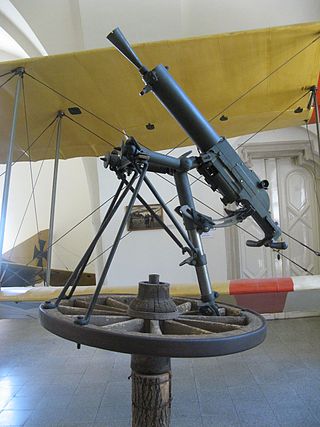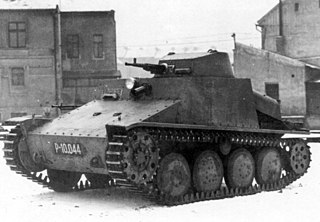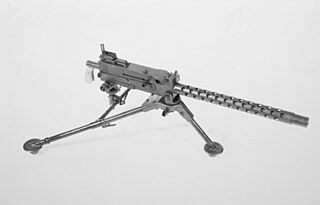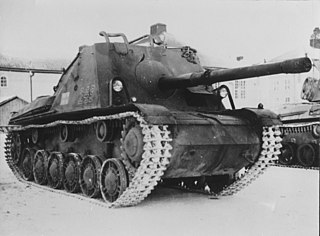
The Panzer II is the common name used for a family of German tanks used in World War II. The official German designation was Panzerkampfwagen II.

The Panzerkampfwagen 38(t), originally known as the ČKD LT vz. 38, was a tank designed during the 1930s, which saw extensive service during World War II. Developed in Czechoslovakia by ČKD, the type was adopted by Nazi Germany following the annexation of Czechoslovakia. With the German Army and other Axis forces, the type saw service in the invasions of Poland, France and the USSR. Production ended in 1942, when its main armament was deemed inadequate. In all, over 1,400 Pz. 38(t)s were manufactured. The chassis of the Pz. 38(t) continued to be produced for the Marder III (1942–1944) with some of its components used in the later Jagdpanzer 38 (1944–1945) tank destroyer and its derivative vehicles.

The MT-LB is a Soviet multi-purpose, fully amphibious, tracked armored fighting vehicle in use since the 1970s. It was also produced in Poland, where its YaMZ engine was replaced by a Polish 6-cylinder SW 680 diesel engine.

The Bofors 37 mm anti-tank gun was an anti-tank gun designed by Swedish manufacturer Bofors in the early 1930s originally for Swedish use. It was exported to several countries during the 1930s of which several bought licences to produce it themselves. The gun was used in several conflicts but most of its fame comes from its use in the Spanish Civil War and the Winter War where it was used very successfully against light tanks and armored cars among other targets. Beyond its use as an infantry gun it was also used as the main armament in several armored cars and tanks such as the Dutch M39 Pantserwagen and the Polish 7TP to name a few. As the armor of tanks was increased during World War II the gun very quickly became obsolete as an anti-tank gun but was still used effectively as an infantry support gun for the entirety of the war, and well into the Cold War. This was due to its high fire rate, great mobility and effective high explosive shells.

The FN MAG is a Belgian 7.62 mm general-purpose machine gun, designed in the early 1950s at Fabrique Nationale (FN) by Ernest Vervier. It has been used by more than 80 countries and it has been made under licence in several countries, including Argentina, Canada, Egypt, India and the United Kingdom.

The Turán tanks were a series of Hungarian medium tanks of World War II. They were produced in two main variants: the original 40M Turán with a 40 mm gun and later the 41M Turán with a short-barreled 75 mm gun, improved armour and a new turret. A total of 285 40M Turán I tanks were made. The 40M Turán was originally inspired by and used the features found on the design of the Czechoslovak Škoda T-21 medium tank prototype. The Turán tanks fought on the Eastern Front against the Soviets, and in the defence of Hungary.
The M1917 Browning machine gun is a heavy machine gun used by the United States armed forces in World War I, World War II, the Korean War, and the Vietnam War; it has also been used by other nations. It was a crew-served, belt-fed, water-cooled machine gun that served alongside the much lighter air-cooled Browning M1919. It was used at the battalion level, and often mounted on vehicles. There were two main iterations: the M1917, which was used in World War I and the M1917A1, which was used thereafter. The M1917, which was used on some aircraft as well as in a ground role, had a cyclic rate of 450 rounds per minute. The M1917A1 had a cyclic rate of 450 to 600 rounds per minute.

The Maschinengewehr (Schwarzlose) M. 7, also known as the Schwarzlose MG, is a medium machine-gun, used as a standard issue firearm in the Austro-Hungarian Army throughout World War I. It was utilized by the Dutch, Greek and Hungarian armies during World War II. It was routinely issued to Italian colonial troops, alongside the Mannlicher M1895 rifle.

Kulspruta m/42 , Swedish designation for a heavily modified, license-built derivative of the M1919A6 chambered in 6.5×55mm or 8×63mm patron m/32 and from 1975 in 7.62×51mm NATO.

The Landsverk L-180, L-181 and L-182 are a family of armored cars developed by the Swedish company AB Landsverk during the interwar years. They had a good international reputation for being fast, robust and reliable and were acquired in small numbers by Denmark, Estonia, Ireland and the Netherlands, among others.

Stridsvagn m/37 was a Swedish-built version of the Czechoslovak ČKD AH-IV tankette.

The AH-IV was a Czechoslovak-designed export armored fighting vehicle, classed as either a tankette or light tank, used by Romania during World War II, but having also been acquired by neutral Sweden and Iran. Modified AH-IV versions were built under license by Romania (R-1) and Sweden. The Romanian vehicles saw action on the Eastern Front from Operation Barbarossa to the Vienna offensive. Twenty vehicles were sold after the war to Ethiopia, who used them until the 1980s.

Terrängbil m/42 KP, meaning "terrain car m/42 KP", colloquially known as "KP-car", was an early Swedish infantry fighting vehicle developed during World War II. It is at its core a flatbed truck with 4 wheel drive for off-road driving, fitted with an armoured body elongated over and around the bed with a troop transport compartment behind the cabin for a panzergrenadier squad of 16.

The M1919 Browning is a .30 caliber medium machine gun that was widely used during the 20th century, especially during World War II, the Korean War, and the Vietnam War. The M1919 saw service as a light infantry, coaxial, mounted, aircraft, and anti-aircraft machine gun by the U.S. and many other countries.

Landsverk L-10 was a Swedish late interwar era medium tank constructed by AB Landsverk for the Swedish Army between 1930 and 1933.

The 8×63mm patron m/32 was a bottlenecked centrefire cartridge with a slightly rebated rim for Swedish heavy and medium machine guns. It was used from 1932 to the finalisation of the re-chambering process of these machine guns to 7.62×51mm NATO in 1975.
The Ksp 58 is a Swedish variant of the Belgian FN MAG general-purpose machine gun, adopted by the Swedish Armed Forces in 1958.

This article deals with the history and development of tanks employed by the military of Sweden, from the interwar period, and World War II, the Cold War and modern era.

The Pansarvärnskanonvagn m/43 was a tank destroyer developed by Landsverk.

















